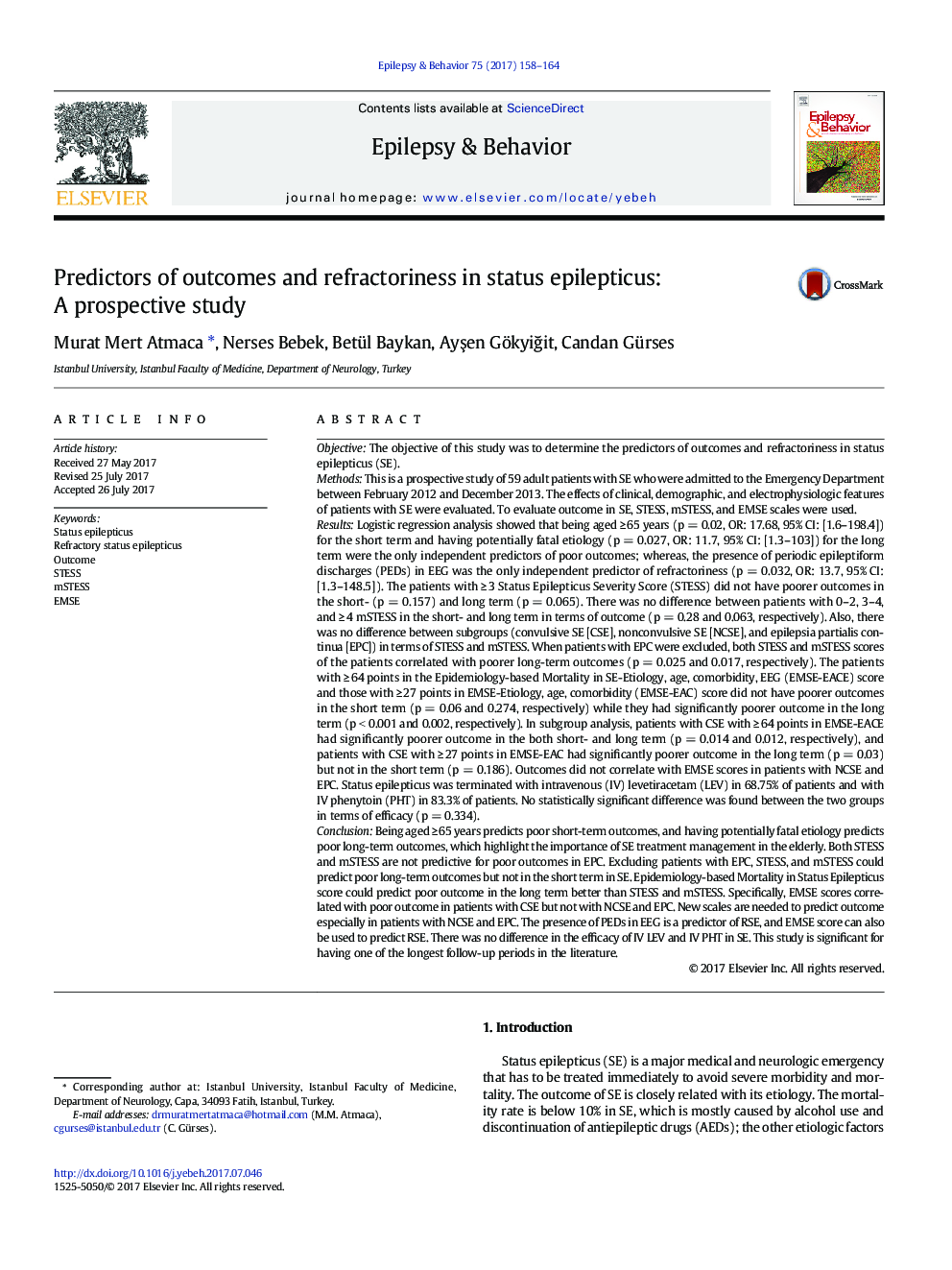| کد مقاله | کد نشریه | سال انتشار | مقاله انگلیسی | نسخه تمام متن |
|---|---|---|---|---|
| 5628158 | 1579818 | 2017 | 7 صفحه PDF | دانلود رایگان |
- Being aged â¥Â 65 years predicts poor short-term outcomes in SE.
- Having potentially fatal etiology predicts poor long-term outcomes in SE.
- STESS is not predictive for poor outcome in EPC.
- STESS (excluding patients with EPC) and mSTESS could predict poor long-term outcome in SE.
- EMSE scores could predict poor long-term outcome better than STESS and mSTESS especially in CSE.
ObjectiveThe objective of this study was to determine the predictors of outcomes and refractoriness in status epilepticus (SE).MethodsThis is a prospective study of 59 adult patients with SE who were admitted to the Emergency Department between February 2012 and December 2013. The effects of clinical, demographic, and electrophysiologic features of patients with SE were evaluated. To evaluate outcome in SE, STESS, mSTESS, and EMSE scales were used.ResultsLogistic regression analysis showed that being aged â¥Â 65 years (p = 0.02, OR: 17.68, 95% CI: [1.6-198.4]) for the short term and having potentially fatal etiology (p = 0.027, OR: 11.7, 95% CI: [1.3-103]) for the long term were the only independent predictors of poor outcomes; whereas, the presence of periodic epileptiform discharges (PEDs) in EEG was the only independent predictor of refractoriness (p = 0.032, OR: 13.7, 95% CI: [1.3-148.5]). The patients with â¥Â 3 Status Epilepticus Severity Score (STESS) did not have poorer outcomes in the short- (p = 0.157) and long term (p = 0.065). There was no difference between patients with 0-2, 3-4, and â¥Â 4 mSTESS in the short- and long term in terms of outcome (p = 0.28 and 0.063, respectively). Also, there was no difference between subgroups (convulsive SE [CSE], nonconvulsive SE [NCSE], and epilepsia partialis continua [EPC]) in terms of STESS and mSTESS. When patients with EPC were excluded, both STESS and mSTESS scores of the patients correlated with poorer long-term outcomes (p = 0.025 and 0.017, respectively). The patients with â¥Â 64 points in the Epidemiology-based Mortality in SE-Etiology, age, comorbidity, EEG (EMSE-EACE) score and those with â¥Â 27 points in EMSE-Etiology, age, comorbidity (EMSE-EAC) score did not have poorer outcomes in the short term (p = 0.06 and 0.274, respectively) while they had significantly poorer outcome in the long term (p < 0.001 and 0.002, respectively). In subgroup analysis, patients with CSE with â¥Â 64 points in EMSE-EACE had significantly poorer outcome in the both short- and long term (p = 0.014 and 0.012, respectively), and patients with CSE with â¥Â 27 points in EMSE-EAC had significantly poorer outcome in the long term (p = 0.03) but not in the short term (p = 0.186). Outcomes did not correlate with EMSE scores in patients with NCSE and EPC. Status epilepticus was terminated with intravenous (IV) levetiracetam (LEV) in 68.75% of patients and with IV phenytoin (PHT) in 83.3% of patients. No statistically significant difference was found between the two groups in terms of efficacy (p = 0.334).ConclusionBeing aged â¥Â 65 years predicts poor short-term outcomes, and having potentially fatal etiology predicts poor long-term outcomes, which highlight the importance of SE treatment management in the elderly. Both STESS and mSTESS are not predictive for poor outcomes in EPC. Excluding patients with EPC, STESS, and mSTESS could predict poor long-term outcomes but not in the short term in SE. Epidemiology-based Mortality in Status Epilepticus score could predict poor outcome in the long term better than STESS and mSTESS. Specifically, EMSE scores correlated with poor outcome in patients with CSE but not with NCSE and EPC. New scales are needed to predict outcome especially in patients with NCSE and EPC. The presence of PEDs in EEG is a predictor of RSE, and EMSE score can also be used to predict RSE. There was no difference in the efficacy of IV LEV and IV PHT in SE. This study is significant for having one of the longest follow-up periods in the literature.
Journal: Epilepsy & Behavior - Volume 75, October 2017, Pages 158-164
